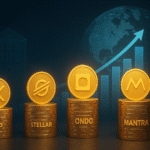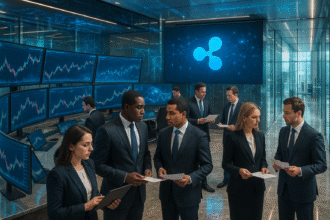The Need for a Store of Value
In an era of unprecedented monetary expansion and rising inflation, the search for a reliable store of value (SoV) has become a central theme for investors and financial institutions alike. An effective SoV is an asset that maintains its purchasing power over a long period, ideally resisting the corrosive effects of inflation and economic instability. The defining characteristics of a robust SoV include scarcity, durability, fungibility, and portability.
For millennia, Gold has been the quintessential example of a store of value, a physical asset that has endured countless economic cycles and political upheavals. Yet, the 21st century has introduced a formidable, purely digital challenger: Bitcoin. Often referred to as “digital gold,” Bitcoin claims to offer a superior, modern alternative to the ancient metal. This article aims to analyze both assets against the fundamental criteria of a store of value, setting the stage for a detailed, head-to-head comparison of the two most prominent inflation hedges available today.
Gold: The Timeless Standard
Gold’s status as a store of value is unparalleled, rooted in a history that stretches back over 5,000 years. Its adoption across diverse cultures and civilizations has cemented its role as a universal currency and a reliable hedge against uncertainty. This deep-seated trust is perhaps Gold’s most significant advantage.
The physical properties of Gold contribute directly to its effectiveness as an SoV. It is inherently scarce, with all the Gold ever mined still existing in some form, though the rate of new supply (or “mine production”) continues to add to the total stock. It is virtually indestructible (durable) and easily verifiable through standard metallurgical tests. Furthermore, Gold is highly fungible; an ounce of pure Gold in London is considered equal in value to an ounce of pure Gold in Tokyo, ensuring global acceptance.
However, Gold’s physical nature also presents significant drawbacks. It is expensive and cumbersome to store securely, requiring vaults, insurance, and physical transport. Verification can be complex and costly, and its divisibility is limited by its physical form. For an increasingly digital world, these limitations have opened the door for a more technologically advanced solution.
Bitcoin: The Digital Challenger (“Digital Gold”)
The emergence of Bitcoin in 2009 introduced the concept of a digital, decentralized, and mathematically scarce asset. It earned the moniker “digital gold” because it mirrors several of Gold’s most valuable attributes while addressing its physical limitations.
Bitcoin’s most compelling feature is its absolute, verifiable scarcity. The protocol is programmed to cap the total supply at 21 million coins, a limit that cannot be altered by any central authority, government, or bank. This hard cap is the foundation of its value proposition as a non-inflationary asset.
In terms of the other SoV criteria, Bitcoin excels in the digital realm. It is highly portable, allowing billions of dollars worth of value to be transferred across borders in minutes with minimal cost, requiring only a private key. It is infinitely divisible, with the smallest unit (a Satoshi) representing one hundred millionth of a Bitcoin. Its verifiability is transparent and instant, as every transaction and the total supply can be audited on the public blockchain.
Despite its advantages, Bitcoin faces challenges, primarily its extreme price volatility and its relatively short track record. Its value can fluctuate dramatically over short periods, which undermines the traditional definition of a stable store of value. Furthermore, the regulatory landscape remains uncertain, and the technology is still young compared to Gold’s multi-millennial history.
Direct Comparison: Head-to-Head Analysis
To effectively compare these two assets, we must evaluate them side-by-side against the core characteristics of a store of value. The table below summarizes the key differences:
| Characteristic | Gold | Bitcoin | Analysis |
| Scarcity | Finite, but new supply is continually mined (approx. 1.5% per year) | Absolute hard cap of 21 million coins, mathematically enforced | Bitcoin offers superior, verifiable scarcity. |
| History/Track Record | Over 5,000 years of acceptance as money and value | Approximately 15 years as a financial asset | Gold has the undisputed advantage of historical trust and longevity. |
| Portability | Low. Costly and difficult to transport and secure physically | High. Value is stored digitally and can be transferred globally instantly | Bitcoin is vastly superior in terms of portability and ease of transfer. |
| Divisibility | Limited by physical form (bars, coins) | Highly divisible (down to 8 decimal places – Satoshis) | Bitcoin is superior for micro-transactions and precise value storage. |
| Fungibility | High. Globally accepted standard of purity | High. Every Bitcoin is identical and interchangeable on the network | Both assets are highly fungible. |
| Security | Physical security (vaults, insurance) and counterparty risk | Cryptographic security (private keys) and network security | Security relies on different methods; Gold on physical protection, Bitcoin on mathematics. |
| Volatility | Relatively low (average around 1.2%) | High (1-year volatility around 50%) | Gold offers greater price stability, a key trait of a traditional SoV. |
| Market Cap | Estimated at over $13 trillion | Estimated at over $1.5 trillion | Gold remains the larger, more established market. |
The Modern Context: Inflation, Technology, and Future Potential
The performance of Gold and Bitcoin in the modern macroeconomic environment offers a mixed picture. Gold typically acts as a reliable inflation hedge, showing resilience when fiat currencies lose purchasing power. Bitcoin’s performance, however, has been more complex. While it is fundamentally a deflationary asset due to its fixed supply, its price has often shown a high correlation with risk-on assets like technology stocks, especially during periods of market stress. This correlation suggests that, for now, Bitcoin is still perceived by many as a growth asset rather than a pure safe-haven asset like Gold.
A notable trend is the shifting preference among demographics. Younger investors, who are digital natives and often skeptical of traditional financial institutions, tend to favor Bitcoin for its accessibility, transparency, and technological elegance. Furthermore, institutional adoption has been a major catalyst for both. The introduction of Gold and Bitcoin Exchange-Traded Funds (ETFs) has made both assets accessible to a wider range of traditional investors, legitimizing Bitcoin’s role in diversified portfolios.
Coexistence or Replacement?
The debate between Gold and Bitcoin as the superior store of value is not a simple choice between old and new; it is a comparison between proven history and technological innovation.
Gold’s strength lies in its unquestionable history and its psychological comfort as a tangible asset. It is the established champion, offering stability and a reliable hedge against systemic risk. Bitcoin’s strength, conversely, is its superior digital utility. Its verifiable scarcity, ease of transfer, and resistance to censorship make it a powerful tool for wealth preservation in the digital age.
The most pragmatic conclusion is that the two assets are not mutually exclusive. For the foreseeable future, Gold will continue to serve as the bedrock of conservative portfolios, valued for its stability and historical track record. Bitcoin, meanwhile, will likely continue to mature, with its volatility gradually decreasing as its market capitalization grows and adoption widens.
Ultimately, both Gold and Bitcoin serve a similar purpose—to hedge against the debasement of fiat currency—but they do so in different ecosystems. A diversified portfolio may well include both: Gold for stability and historical assurance, and Bitcoin for its asymmetric growth potential and superior digital properties. The future of wealth preservation may not be a replacement, but a coexistence, with each asset playing a vital, complementary role.
ISO 20022 Risks: Are Banks Truly Ready?
Mastering Beginner Investments
Gold, Dollar and Bitcoin: Opportunity, Crisis and Manipulation
Gold as Currency. World Gold Council.
Bitcoin versus Gold: The heavyweights duel





